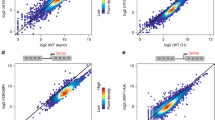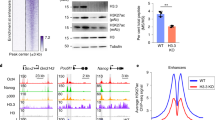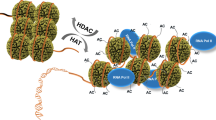Abstract
Transcription factors carry functional domains, which are often physically distinct, for sequence-specific DNA binding, transcriptional activation and regulatory functions. The transcription factor ATF-2 is a DNA-binding protein that binds to cyclic AMP-response elements (CREs), forms a homodimer or heterodimer with c-Jun, and stimulates CRE-dependent transcription1,2,3. Here we report that ATF-2 is a histone acetyltransferase (HAT), which specifically acetylates histones H2B and H4 in vitro. Motif A, which is located in the HAT domain, is responsible for the stimulation of CRE-dependent transcription; moreover, in response to ultraviolet irradiation, phosphorylation of ATF-2 is accompanied by enhanced HAT activity of ATF-2 and CRE-dependent transcription. These results indicate that phosphorylation of ATF-2 controls its intrinsic HAT activity and its action on CRE-dependent transcription. ATF-2 may represent a new class of sequence-specific factors, which are able to activate transcription by direct effects on chromatin components.
This is a preview of subscription content, access via your institution
Access options
Subscribe to this journal
Receive 51 print issues and online access
$199.00 per year
only $3.90 per issue
Buy this article
- Purchase on Springer Link
- Instant access to full article PDF
Prices may be subject to local taxes which are calculated during checkout




Similar content being viewed by others
References
Hai, T., Liu, F., Coukos, W. J. & Green, M. R. Transcription factor ATF cDNA clones: an extensive family of leucine zipper proteins able to selectively form DNA-binding heterodimers. Genes Dev. 3, 2083–2090 (1989).
Maekawa, T. et al. Leucine zipper structure of the protein CRE-BP 1 binding to the cyclic AMP-response element in brain. EMBO J. 8, 2023–2028 (1989).
Ptashne, M. & Gann, A. Transcriptional activation by recruitment. Nature 386, 569–573 (1997).
Brownell, J. E. et al. Tetrahymena histone acetyltransferase A: a homolog of yeast Gcn5p linking histone acetylation to gene activation. Cell 84, 843–851 (1996).
Ogryzko, V. V., Schiltz, R. L., Russanova, V., Howard, B. H. & Nakatani, Y. The transcriptional coactivators p300 and CBP are histone acetyltransferases. Cell 87, 953–959 (1996).
Bannister, A. J. & Kouzarides, T. The CBP co-activator is a histone acetyltransferase. Nature 384, 641–643 (1996).
Yang X. J., Ogryzko, V. V., Nishikawa, J., Howard, B. H. & Nakatani, Y. A p300/CBP-associated factor that competes with the adenoviral oncoprotein E1A. Nature 382, 319–324 (1996).
Chen, H. et al. Nuclear receptor coactivator ACTR is a novel histone acetyltransferase and forms a multimeric activation complex with P/CAF and CBP/p300. Cell 90, 569–580 (1997).
Spencer, T. E. et al. Steroid receptor coactivator-1 is a histone acetyltransferase. Nature 389, 194–198 (1997).
Imhof, A. et al. Acetylation of general transcription factors by histone acetyltransferases. Curr. Biol. 7, 689–692 (1997).
Torchia, J. et al. The transcriptional co-activator p/CIP binds CBP and mediates nuclear-receptor function. Nature 387, 677–684 (1997).
Struhl, K. Histone acetylation and transcriptional regulatory mechanisms. Genes Dev. 12, 599–606 (1998).
Brown, C. E., Lechner, T., Howe, L. & Workman, J. L. The many HATs of transcription coactivators. Trends Biochem. Sci. 25, 15–19 (2000).
Kawasaki, H. et al. p300 and ATF-2 are components of the DRF complex, which regulates retinoic acid- and E1A-mediated transcription of the c-jun gene in F9 cells. Genes Dev. 12, 233–245 (1998).
Liu, F. & Green, M. A specific member of the ATF transcription factor family can mediate transcription activation by the adenovirus E1A protein. Cell 61, 1217–1224 (1990).
Schiltz, R. L. et al. Overlapping but distinct patterns of histone acetylation by the human coactivators p300 and PCAF within nucleosome substrates. J. Biol. Chem. 274, 1189–1192 (1999).
Martinez-Balbas, M. A. et al. The acetyltransferase activity of CBP stimulates transcription. EMBO J. 17, 2886–2893 (1998).
Dutnall, R. N., Tafrov, S. T., Stermglanz, R. & Ramakrishnam, V. Structure of the histone acetyltranscferase Hat1: a paradigm for the GCN5-related N-acetyltransferase superfamily. Cell 94, 427–438 (1998).
Eckner, R., Yao, T. -S., Oldread, E. & Livingston, D. M. Molecular cloning and functional analysis of the adenovirus E1A-associated 300-kDa protein (p300) reveals a protein with properties of a transcriptional adaptor. Genes Dev. 8, 869–884 (1994).
Herrlich, P., Blattner, C., Knebel, A., Bender, K. & Rahmsdorf, H. J. Nuclear and non-nuclear targets of genotoxic agents in the induction of gene expression. Shared principles in yeast, rodents, man and plants. Biol. Chem. 378, 1217–1229 (1997).
van Dam, H. et al. ATF-2 is preferentially activated by stress-activated protein kinases to mediate c-Jun induction in response to genotoxic agents. EMBO J. 14, 1798–1811 (1995).
Livingston, C., Patel, G. & Jones, N. C. ATF-2 contains a phosphorylation-dependent transcriptional activation domain. EMBO J. 14, 1785–1797 (1995).
Luger, K., Mader, A. W., Richmond, R. K., Sargent, D. F. & Richmond, T. J. X-ray structure of the nucleosome core particle at 2.8Å resolution. Nature 389, 251–259 (1997).
Gu, W. & Roeder, R. G. Activation of p53 sequence-specific DNA binding by acetylation of the p53 C-terminal domain. Cell 90, 595–606 (1997).
Zhang, W. & Bieker, J. J. Acetylation and modulation of erythroid Krüppel-like factor (EKLF) activity by interaction with histone acetyltransferases. Proc. Natl Acad. Sci. USA 95, 9855–9860 (1998).
Boyes, J., Byfield, P., Nakatani, Y. & Ogryzko, V. V. Regulation of activity of the transcription factor GATA-1 by acetylation. Nature 396, 594–598 (1998).
Kawasaki, H. et al. Distinct roles of the co-activators p300 and CBP in retinoic acid-induced F9-cell differentiation. Nature 393, 284–289 (1998).
Montminy, M. R. & Beiezikjian, J. M. Binding of a nuclear protein to the cyclic-AMP response element of the somatostatin gene. Nature 328, 175–178 (1987).
Bender, K., Gottlicher, M., Whiteside, S., Rahmsdorf, H. J. & Herrlich, P. Sequential DNA damage-independent and -dependent activation of NF-kB by ultraviolet. EMBO J. 17, 5710–5181 (1998).
Acknowledgements
We thank T. Nakajima, S. Ishii, N. Jones, M. Green and M. Karin for providing reagents; C. Geltinger, G. Gachelin, T-P. Yao, D. M. Livingston, A. P. Wolffe and R. Eckner for discussions; and N. Day, A. Körner and B. C. An der Lan for critical reading of the manuscript. This work was supported by the NIH (R.C., Y.N., K.I.), by the Special Cooperation Funds of the Science and Technology Agency, and by Grants-in-Aid from the Ministry of Education, Science, Sports and Culture of Japan (K.K.Y.).
Author information
Authors and Affiliations
Corresponding author
Supplementary information
Supplementary Information
Supplementary Information (PDF 747 kb)
Rights and permissions
About this article
Cite this article
Kawasaki, H., Schiltz, L., Chiu, R. et al. ATF-2 has intrinsic histone acetyltransferase activity which is modulated by phosphorylation. Nature 405, 195–200 (2000). https://doi.org/10.1038/35012097
Received:
Accepted:
Issue Date:
DOI: https://doi.org/10.1038/35012097
This article is cited by
-
ATF2-driven osteogenic activity of enoxaparin sodium-loaded polymethylmethacrylate bone cement in femoral defect regeneration
Journal of Orthopaedic Surgery and Research (2023)
-
H3K27ac mediated SS18/BAFs relocation regulates JUN induced pluripotent-somatic transition
Cell & Bioscience (2022)
-
NEDD4L represses prostate cancer cell proliferation via modulating PHF8 through the ubiquitin–proteasome pathway
Clinical and Translational Oncology (2022)
-
Deletion of Jdp2 enhances Slc7a11 expression in Atoh-1 positive cerebellum granule cell progenitors in vivo
Stem Cell Research & Therapy (2021)
-
Unraveling the epigenetic landscape of glomerular cells in kidney disease
Journal of Molecular Medicine (2021)
Comments
By submitting a comment you agree to abide by our Terms and Community Guidelines. If you find something abusive or that does not comply with our terms or guidelines please flag it as inappropriate.



